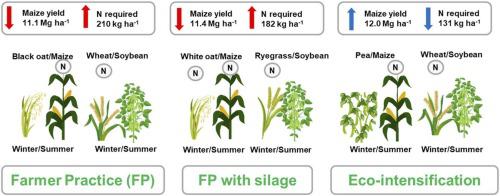当前位置:
X-MOL 学术
›
Eur. J. Agron.
›
论文详情
Our official English website, www.x-mol.net, welcomes your feedback! (Note: you will need to create a separate account there.)
Eight years of eco-intensification of maize-soybean rotation in south Brazil: Maize grain production and nitrogen fertilizer replacement value
European Journal of Agronomy ( IF 4.5 ) Pub Date : 2024-06-27 , DOI: 10.1016/j.eja.2024.127261 Rafael Otto , Gabriel Barth , Murilo Nunes Valenciano , Johnny Rodrigues Soares , Eros Artur Bohac Francisco , Luis Ignacio Prochnow
European Journal of Agronomy ( IF 4.5 ) Pub Date : 2024-06-27 , DOI: 10.1016/j.eja.2024.127261 Rafael Otto , Gabriel Barth , Murilo Nunes Valenciano , Johnny Rodrigues Soares , Eros Artur Bohac Francisco , Luis Ignacio Prochnow

|
The ecological intensification (EI) can reduce the usage of N fertilizers in agriculture by increasing crops diversity, stimulating N fixation, and recycling plant nutrients in soil. In the present study, we aimed to evaluate the EI system compared with farmer practice (FP) and FP with silage (FPS), according to N rate, in the yield of maize and soybean, N agronomic efficiency (NAE), and N fertilizer replacement value (NFRV). A long-term experiment was established in 2011 in Ponta Grossa, Brazil, and evaluated during eight seasons. The treatments were arranged in a split-plot design, with three systems (FP, FPS, and EI) as main plot, and N rate applied to maize as subplot at 0, 70, 140, and 210 kg ha, with four replicates. The systems consisted of rotational of maize and soybean in a no-till during summer, with different cover crops and fertilization in winter; in the FP, black oat and wheat were cultivated, white oat and ryegrass in FPS, pea and wheat in EI (without fertilizer). All treatments were duplicated to evaluate the crops in all seasons. The maize yield ranged from 9.3 to 12.6 Mg ha in the eight seasons, where the EI showed higher production than FP and FPS. In the average, the maize accumulated yield (eight seasons) was 5–7 Mg ha higher (0.6–0.9 Mg ha year) in EI compared to FP and FPS. The soybean yield was not influenced by the systems or residual N application. The seasons influenced the maize yield, in which the seasons 2017/18 and 2018/19 resulted in the highest maize yield for all systems, and the season 2015/16 showed the lowest. The production of pea aboveground biomass had small variation between the seasons. The NFRV (N saved) for maximum yield was 16 kg ha yr (8 % of N applied) in the FPS, and 79 kg ha yr (38 % of N applied) in the EI, comparing to N required in FP. The NAE was lower in the EI than the FP and FPS and decreased with increase in N rate; e.g., in the season 2011/12, the NAE was 11 kg kg in the EI and 30 kg kg in the FP and FPS. The eco-intensification system resulted in higher maize yield and lower N required compared to FP, which can be strategic to increase crop yield, reduce N application, and moving towards regenerative agricultural systems.
中文翻译:

巴西南部玉米-大豆轮作生态集约化八年:玉米产量和氮肥替代价值
生态集约化(EI)可以通过增加作物多样性、刺激固氮和循环利用土壤中的植物养分来减少农业中氮肥的使用。在本研究中,我们的目的是根据施氮量、玉米和大豆产量、氮农艺效率 (NAE) 和氮肥,与农民实践 (FP) 和青贮饲料 FP (FPS) 相比,评估 EI 系统重置价值(NFRV)。 2011 年,巴西蓬塔格罗萨开展了一项长期实验,并在八个季节进行了评估。处理采用裂区设计,以 FP、FPS 和 EI 三个系统为主区,玉米施氮量为 0、70、140 和 210 kgha 作为次区,设置 4 个重复。该系统包括夏季免耕轮作玉米和大豆,冬季种植不同的覆盖作物和施肥; FP中种植黑燕麦和小麦,FPS中种植白燕麦和黑麦草,EI中种植豌豆和小麦(不施肥)。所有处理均重复进行,以评估所有季节的作物。八个季节的玉米产量范围为 9.3 至 12.6 毫克公顷,其中 EI 的产量高于 FP 和 FPS。平均而言,与 FP 和 FPS 相比,EI 玉米累计产量(八个季节)高 5-7 毫克公顷(每年 0.6-0.9 毫克公顷)。大豆产量不受系统或残留施氮的影响。季节对玉米产量有影响,其中2017/18和2018/19年度各系统玉米产量最高,2015/16年度最低。豌豆地上生物量产量随季节变化较小。 与 FP 所需的氮相比,FPS 中最大产量的 NFRV(节省的氮)为 16 千克公顷年(施氮量的 8%),EI 中为 79 千克公顷年(施氮量的 38%)。 EI中的NAE低于FP和FPS,并随着施氮量的增加而降低;例如,2011/12赛季,EI中的NAE为11kgkg,FP和FPS中的NAE为30kgkg。与FP相比,生态集约化系统带来了更高的玉米产量和更低的氮素需求,这对于提高作物产量、减少氮肥施用和转向再生农业系统具有战略意义。
更新日期:2024-06-27
中文翻译:

巴西南部玉米-大豆轮作生态集约化八年:玉米产量和氮肥替代价值
生态集约化(EI)可以通过增加作物多样性、刺激固氮和循环利用土壤中的植物养分来减少农业中氮肥的使用。在本研究中,我们的目的是根据施氮量、玉米和大豆产量、氮农艺效率 (NAE) 和氮肥,与农民实践 (FP) 和青贮饲料 FP (FPS) 相比,评估 EI 系统重置价值(NFRV)。 2011 年,巴西蓬塔格罗萨开展了一项长期实验,并在八个季节进行了评估。处理采用裂区设计,以 FP、FPS 和 EI 三个系统为主区,玉米施氮量为 0、70、140 和 210 kgha 作为次区,设置 4 个重复。该系统包括夏季免耕轮作玉米和大豆,冬季种植不同的覆盖作物和施肥; FP中种植黑燕麦和小麦,FPS中种植白燕麦和黑麦草,EI中种植豌豆和小麦(不施肥)。所有处理均重复进行,以评估所有季节的作物。八个季节的玉米产量范围为 9.3 至 12.6 毫克公顷,其中 EI 的产量高于 FP 和 FPS。平均而言,与 FP 和 FPS 相比,EI 玉米累计产量(八个季节)高 5-7 毫克公顷(每年 0.6-0.9 毫克公顷)。大豆产量不受系统或残留施氮的影响。季节对玉米产量有影响,其中2017/18和2018/19年度各系统玉米产量最高,2015/16年度最低。豌豆地上生物量产量随季节变化较小。 与 FP 所需的氮相比,FPS 中最大产量的 NFRV(节省的氮)为 16 千克公顷年(施氮量的 8%),EI 中为 79 千克公顷年(施氮量的 38%)。 EI中的NAE低于FP和FPS,并随着施氮量的增加而降低;例如,2011/12赛季,EI中的NAE为11kgkg,FP和FPS中的NAE为30kgkg。与FP相比,生态集约化系统带来了更高的玉米产量和更低的氮素需求,这对于提高作物产量、减少氮肥施用和转向再生农业系统具有战略意义。











































 京公网安备 11010802027423号
京公网安备 11010802027423号